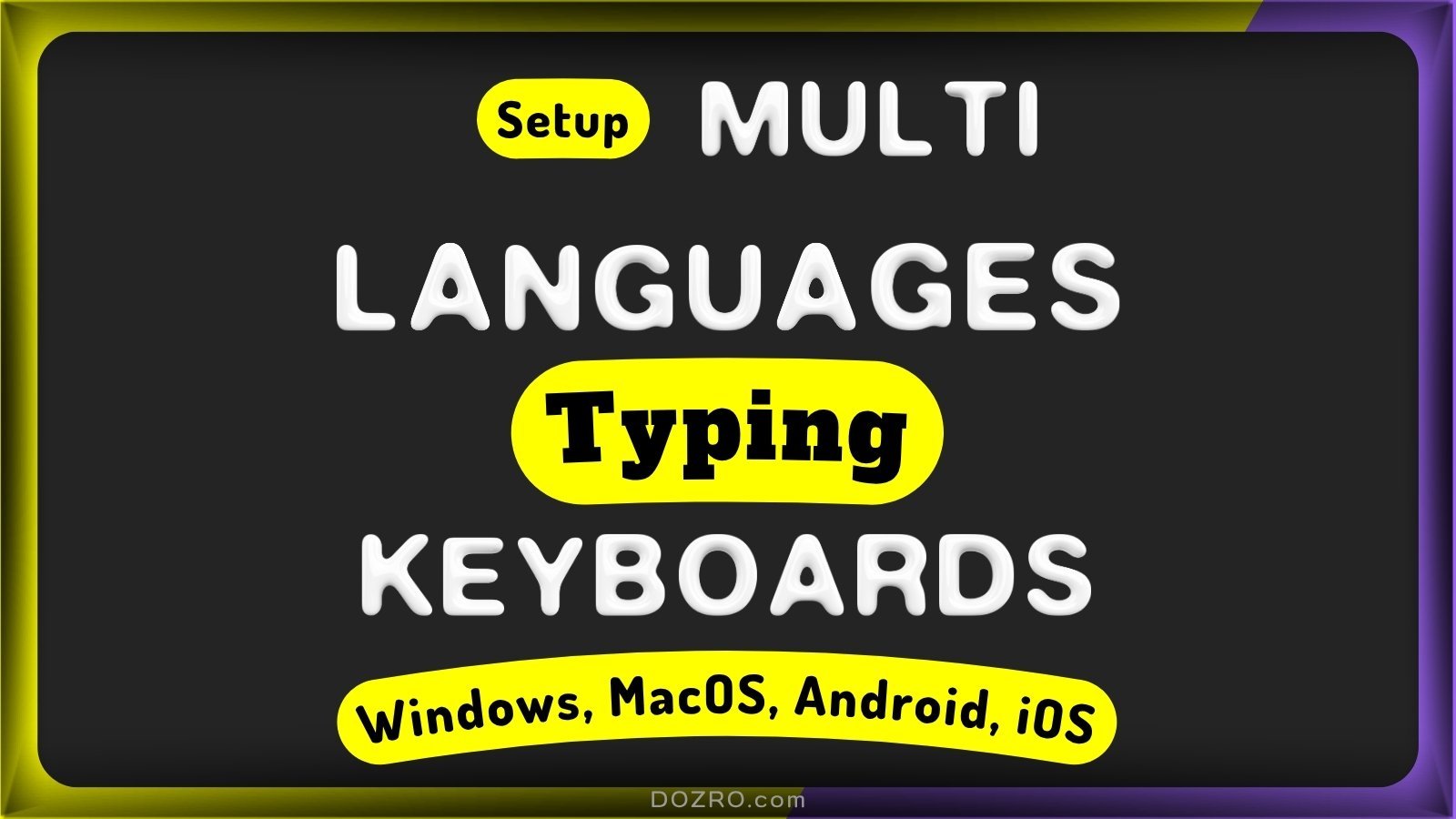How to Setup/Switch Multilingual Keyboards for Typing on Windows, MacOS, Android, iOS Devices
If you've been using our typing speed tests in English, French, Spanish, Chinese, Japanese, or Urdu, you might have noticed that simply opening the test doesn't automatically change your keyboard language. That's because our typing test tools, while powerful for measuring your speed and accuracy, don't control your device's input settings. To type in a specific language, you need to configure your computer or mobile device's keyboard settings.
This article will guide you through the process of adding and switching between keyboard languages on popular operating systems. While the instructions are general and apply to any language you wish to type, we'll use Urdu as a common example.
1. Setting Up Your Keyboard on Windows
Windows provides robust support for multiple input languages and keyboard layouts.
Access Language Settings:
Click on the Start button (Windows icon).
Go to Settings (gear icon).
Select Time & Language.
In the right-hand menu, click on Language & Region (or simply Language in older versions).
Add a New Language:
Under "Preferred languages," click the "Add a language" button.
A list of languages will appear. Search for the language you wish to add, for example, "Urdu" (اردو).
Select it and click Next.
Ensure "Install language pack", “Basic typing”, and "Text-to-speech" (if desired) are checked, then click Install.
Switch Keyboard Layouts:
Once the language pack is installed, you'll see your newly added language in the "Preferred languages" list.
To switch between languages, click on the language indicator in your taskbar, on bottom right corner of screen (usually "ENG," "FRA," "ESP," etc., near the clock). A small pop-up will appear, allowing you to select your desired language, e.g., Urdu.
Tip: You can also use the keyboard shortcut
Windows key+Spacebarto quickly cycle through your installed languages.
Optional: Add a Phonetic Layout (e.g., Urdu Phonetic):
For some languages like Urdu, a "phonetic" layout is often preferred, where typing an English letter produces a phonetically similar character in the target language (e.g., typing 'k' might produce 'ک').
In the "Preferred languages" list, click the three dots (...) next to your added language (e.g., Urdu).
Select Language options.
Under the "Keyboards" section, click "Add a keyboard".
Choose "Urdu Phonetic" (or the phonetic layout for your desired language). You can then remove the default "Urdu" if you prefer the phonetic layout.
How to Setup Multilingual Keyboards for Typing on Windows, MacOS, Android, iOS Devices
2. Setting Up Your Keyboard on macOS
macOS offers a straightforward way to manage input sources.
Access Keyboard Settings:
Click the Apple menu in the top-left corner of your screen.
Select System Settings (or System Preferences in older versions).
Click on Keyboard in the sidebar.
Add an Input Source:
Scroll down or look for the "Input Sources" section.
Click the "Edit..." button (or the + icon in older versions).
In the left sidebar of the new window, find and select your desired language, for example, "Urdu".
On the right, choose the specific keyboard layout (e.g., "Urdu (PC)," "Urdu - Standard," or "Urdu - Phonetic").
Click Add.
Switch Input Sources:
An Input menu icon (often a flag or a character symbol) will appear in your menu bar at the top of the screen.
Click on this icon and select your newly added language (e.g., Urdu) from the dropdown list.
Tip: You can also use the keyboard shortcut
Control+Spacebar(orFn+Control+Spacebaron some keyboards) to quickly switch between your active input sources.
3. Setting Up Your Keyboard on Android Devices
For typing on your Android phone or tablet, you'll manage keyboard languages through your installed keyboard app.
Access Language & Input Settings:
Open your device's Settings app.
Scroll down and tap on System or General Management (the exact name may vary).
Tap on Languages & input.
Manage Virtual Keyboard:
Under "Keyboards" or "Virtual keyboard," tap on On-screen keyboard.
Select your primary keyboard app (e.g., Gboard, SwiftKey, or Samsung Keyboard).
Add a Language:
Within the keyboard app's settings, find and tap Languages.
Tap "Add keyboard" (or similar option).
Search for and select your desired language, for example, "Urdu".
You may be prompted to select a layout (e.g., QWERTY, phonetic, or a native script layout). Choose the one that suits you best.
Switch Languages while Typing:
When you are in any typing field, your keyboard will appear.
To switch languages, long-press the spacebar or tap the globe icon (🌍) that often appears next to the spacebar. This will cycle through your installed languages.
4. Setting Up Your Keyboard on iOS Devices (iPhone/iPad)
iOS makes it very easy to add and switch between keyboard languages.
Access Keyboard Settings:
Open your device's Settings app.
Tap on General.
Scrol down and tap on Keyboard.
Add a New Keyboard:
Tap on Keyboards at the top.
Tap "Add New Keyboard...".
Scroll through the list or search for your desired language, for example, "Urdu".
Tap on it to add it. You might have options for different layouts (e.g., "Urdu (Pakistan)", "Urdu (India)", or a phonetic layout if available).
Switch Keyboards while Typing:
When you are in any typing field, your keyboard will appear.
To switch languages, tap the globe icon (🌐) repeatedly. Each tap will cycle through your enabled keyboard languages.
How to View the Layouts of Windows Keyboards
If you want to see how different language keyboards are arranged in Windows, Microsoft provides an official reference with visual layouts. This is especially useful when practicing multilingual typing or learning new scripts.
👉 You can explore the full list of layouts Here.
By following these instructions, you'll be able to activate the necessary keyboard layout on your device and type in any language supported by your operating system, making our multilingual typing tests fully functional and enjoyable for you!
Explore More
Discover more on the Homepage of our website. Discover Over 100 typing tests for Multiple Languages. Discover Over 100 Virtual Keyboards with Voice Typing and Translation for Multiple Languages.

